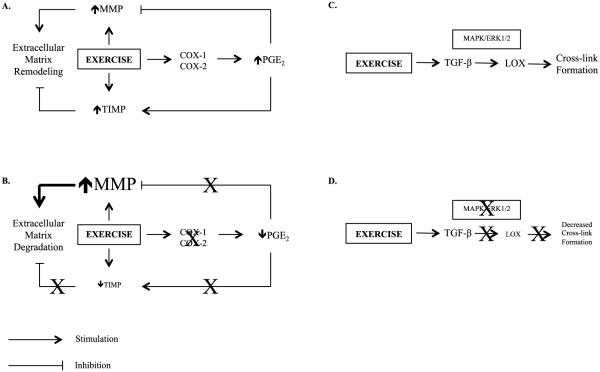Figure 2.
Schematic representation highlighting the novel hypothesis that some analgesic medications alter extracellular matrix remodeling and tissue mechanical properties by modifying fibroblast production of growth factors and matrix enzymes. Emphasis is placed on known and potential targets of APAP and possibly other COX-inhibiting drugs. Panel A: Impact of exercise on PGE2, MMPs, TIMPS, and ECM remodeling when no analgesics are consumed. Exercise increases activity of both MMPs and TIMPs, while PGE2, via COX, limits the increase in MMPs but enhances activation of TIMPs. Panel B: Impact of exercise on PGE2, MMPs, TIMPS, and ECM remodeling during chronic consumption of analgesics. I hypothesize that inhibition of PGE2 may result in excess extracellular matrix degradation due to lack of inhibition of MMPs and reduced activation of TIMPs leading to an environment favoring ECM degradation. Panel C: Regulation of cross-link formation when no analgesics are consumed. TGF-β, via MAPK/ERK1/2, stimulates LOX activity and cross-link formation, an effect that is enhanced by exercise. Panel D: Activation of LOX and cross-link formation during chronic consumption of analgesics. I hypothesize that some analgesics inhibit MAPK/ERK1/2, and possibly other signaling molecules, leading to reduced LOX activity and reduced cross-link formation. I hypothesize that the analgesic-induced ECM degradation and reduce cross-link formation contribute to reductions in connective tissue stiffness. Cyclooxygenase (COX), Matrix Metalloproteinase (MMP), Prostaglandin E2 (PGE2), Tissue Inhibitor of Matrix Metalloproteinase (TIMP), Transforming Growth Factor-β (TGF-β), Lysyl Oxidase (LOX), Mitogen-Activated Protein Kinase (MAPK), Extracellular Signal Regulated Kinase (ERK1/2).

